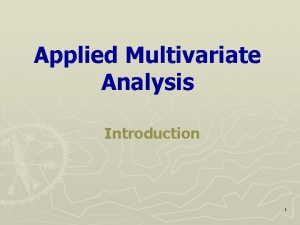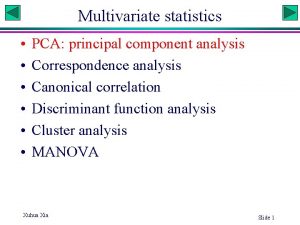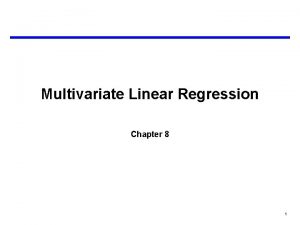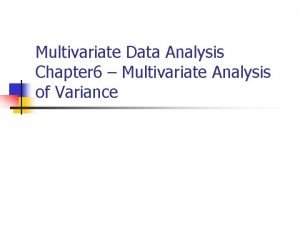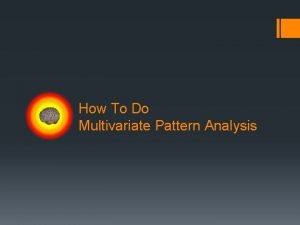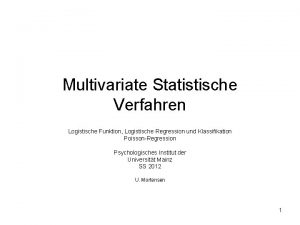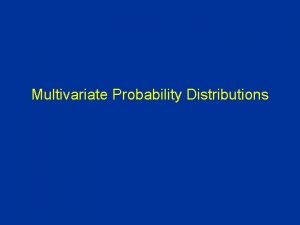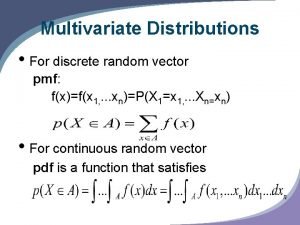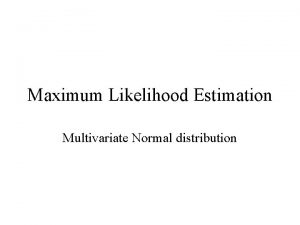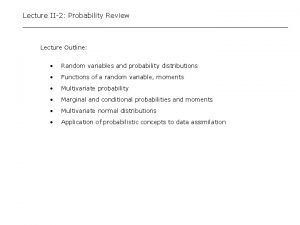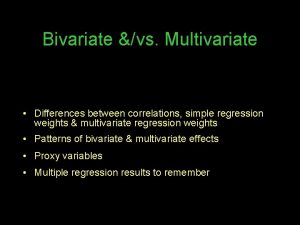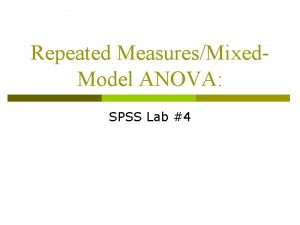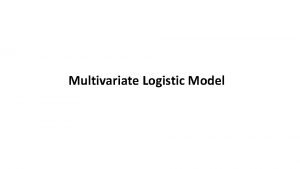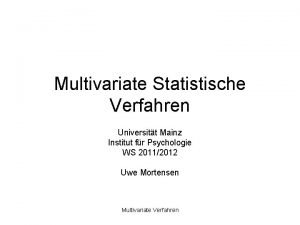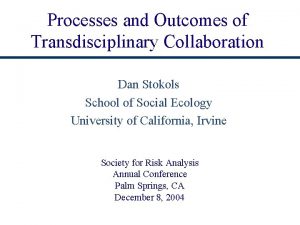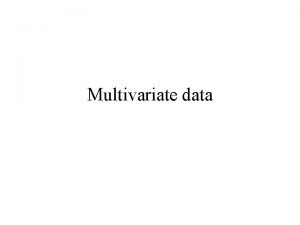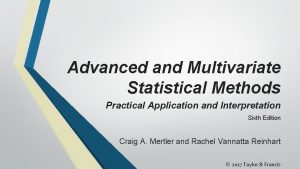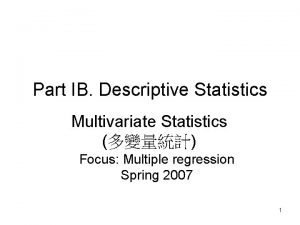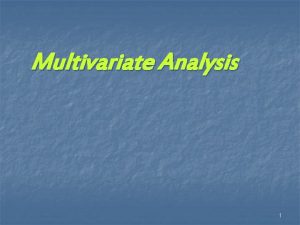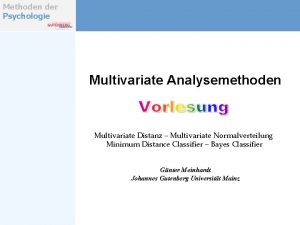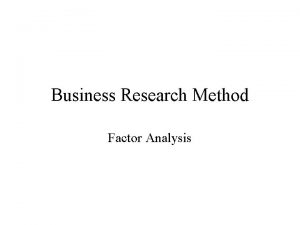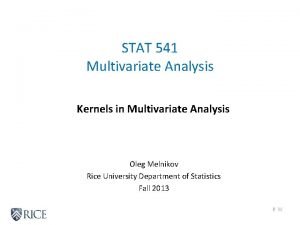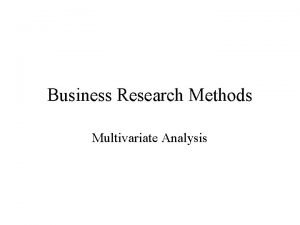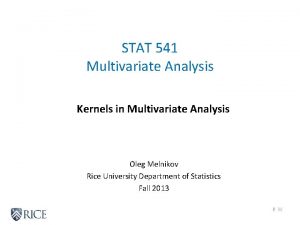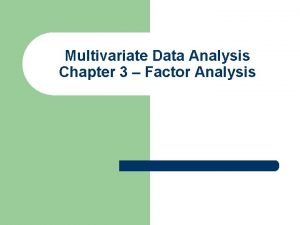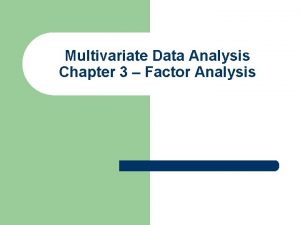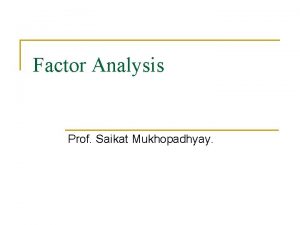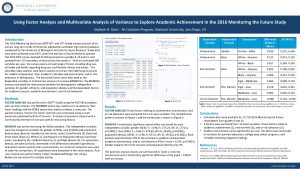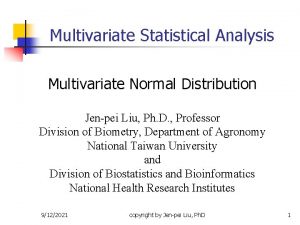Developmental models Multivariate analysis choleski models factor models





















![To Mx! • in baalsimplex: 5 datafiles: iq 4[mzm/dzm/mzf/dos]. rec • 8 variables (missing To Mx! • in baalsimplex: 5 datafiles: iq 4[mzm/dzm/mzf/dos]. rec • 8 variables (missing](https://slidetodoc.com/presentation_image_h2/44af6768d453cab5f7096986c5406a58/image-22.jpg)


- Slides: 24

Developmental models

Multivariate analysis • choleski models • factor models –y= f+u • genetic factor models – Pj = h Gj + c C j + e E j – common pathway – independent pathway

Repeated measures • developmental models – simplex models – growth models

Structural Equation Model • measurement model – relations between latent and observed variables –y= f+u • structural equation model – relations among the latent variables –f=Bf+z

Longitudinal simplex pattern • correlations fall away as time between occasions increase – time 1 – time 2 – time 3 – time 4 – time 5 1 1. 69. 44. 35. 25 2 3 4 5 1. 74. 61. 44 1. 76. 57 1. 73 1

Simplex model • first-order auto-regressive process • each latent variable is influenced by the preceding latent variable: ft = bt ft-1 + zt • b =autoregressive coefficient • z = innovation

Path diagram • units of measurement in the latent variables are the same as in the observed variables • yi = fi + ui and fi = bi fi-1 + zi

First order autoregression (B matrix) • regression coefficients (b 2 to b 4) – 0 – b 2 – 0 0 0 b 3 0 0 b 4 0 0 • no regression coefficient for time 1 (b 1)

Translation into Mx • measurement model Y = F + U • structural model: F = B* F + Z • • F = B * F + Z, therefore: F - B * F = Z, therefore: (I - B) * F = Z, therefore: F = (I - B)-1 * Z • Y = (I - B)-1 * Z + U

Covariance structure • Y = (I - B)-1 * Z + U • Covariance (Y) = • (I-B)-1 * var(Z) * ((I-B)-1 )’ + var(U) – B contains autoregressive coefficients – Z contains innovations – U contains error variances – I is identity matrix

Mx: Longitudinal IQ data (4 ages) • in baalsimplex • 6 rectangular datafiles (raw data): – iq 4 all. rec: N = 209 pairs – iq 4[mzm/dzm/mzf/dos]. rec • missing = -1 • 8 variables: – t 1 iq 5 t 1 iq 7 t 1 iq 10 t 1 iq 12 t 2 iq 5 t 2 iq 7 t 2 iq 10 t 2 iq 12

Dutch IQ data (209 twin pairs) • tested at ages 5, 7, 10 and 12 years • not all twins participated at every occasion! – missing values: fit models to raw data – stability (subdiag=twin 1, superdiag=twin 2): – 5 7 10 12 – 5 1. 57. 62. 53 – 7. 70 1. 70. 61 – 10. 68. 73 1. 69 – 12. 65. 67. 76 1

2 Mx jobs • 1 factor: Pfact 4 iq. mx • simplex: Psimp 4 iq. mx • input file: iq 4 all. rec

output: variances ft = bt ft-1 + zt • var(f t) = bt 2 *var(f t-1 ) + var(zt ) • variance of latent factor (twin 1): – time 1: var(f 1) = var(z 1) = 11. 62 = 134. 1 – time 2: var(f 2) = 1. 12*134. 1 + 4. 62 = 162. 2 • variance of observed variable (twin 1): – time 1: var(f 1) + var(u 1) = 134. 1 + 50. 6 = 184. 7 – time 2: var(f 2) + var(u 2) = 162. 2 + 50. 6 = 212. 8

output: covariances cov(f t , f t-1) = bt*var(f t-1 ) – cov (f 2, f 3) = 1. 0 *162. 2 = 162. 2 – cov (f 3, f 4) = 0. 8 *189. 0 = 151. 2 • cov(f t , f t-2) = bt* bt-1 * var(f t-1 ) – cov (f 1, f 3) = 1. 0 * 1. 1 * 134. 1 = 147. 5

output: correlations • cor(f t , f t-1) = cov(f t , f t-1)/[ var(f t )* var(f t-1)] – cor (f 2, f 3) = 162. 2 / [ 162. 2 * 189. 0] = 0. 93 – cor (f 3, f 4) = 151. 2 / [ 189. 0 * 115. 8] = 1. 00 – cor (f 1, f 3) = 147. 5 / [ 134. 1 * 189. 0] = 0. 93

Extension to genetic designs • For each source of variation (G, E and C (not shown here)) a simplex structure is specified

parameters of the model • • variances of latent factors (G, C and E) at t=0 variances of innovations at t>0 autoregressive coefficients (transmission) variances of measurement errors

Genetic simplex model • G(t) = bg(t) * G(t-1) + zg(t) • E(t) = be(t) * E(t-1) + ze(t) • C(t) = bc(t) * C(t-1) + zc(t) Variances of latent variables: • var(G(t)) = bg(t)2 * var(G(t-1)) + var(zg(t)) • var(E(t)) = be(t)2 * var(E(t-1)) + var(ze(t)) • var(C(t)) = bc(t)2 * var(C(t-1)) + var(zc(t))

specifications • var(G 1) = var(zg(1)) (innovation) • var(G(t)) = bg(t)2 * var(G(t-1)) + var(zg(t)) • cov(G(t), G(t-1)) = bg(t)*var(G(t-1))

Covariance matrix (t=3, no measurement error) Genetic covariance • Var(G 1) • bg 2*var(G 1) • bg 2*bg 3*var(G 1) Var(G 2) bg 3*var(G 2) Var(G 3) Environmental covariance • Var(E 1) • be 2*var(E 1) • be 2*be 3*var(E 1) Var(E 2) be 3*var(E 2) Var(E 3)
![To Mx in baalsimplex 5 datafiles iq 4mzmdzmmzfdos rec 8 variables missing To Mx! • in baalsimplex: 5 datafiles: iq 4[mzm/dzm/mzf/dos]. rec • 8 variables (missing](https://slidetodoc.com/presentation_image_h2/44af6768d453cab5f7096986c5406a58/image-22.jpg)
To Mx! • in baalsimplex: 5 datafiles: iq 4[mzm/dzm/mzf/dos]. rec • 8 variables (missing = -1) – t 1 iq 5 t 1 iq 7 t 1 iq 10 t 1 iq 12 t 2 iq 5 t 2 iq 7 t 2 iq 10 t 2 iq 12 • Mx job: guess. mx: incomplete! – For ages 5, 7 and 10 years only – Full of “mistakes” – fix, run for 3 ages, then adjust and run for 4 ages.

Twin correlations (N) • MZM DZM MZF DOS 5. 77 (42). 53 (43). 77 (47). 73 (37). 65 (39) 7. 56 (37). 41 (41). 78 (42). 50 (34). 56 (38) 10. 73 (38). 54 (41). 87 (43). 46 (37). 50 (37) 12. 87 (30). 62 (33). 87 (36). 60 (31). 24 (34)

Structure MX job • 3 groups to specify the genetic, unique environmental and common environmental simplex structures • 2 data groups to describe the MZ and DZ covariance matrices • MZ: G+C+E | G+C _ G+C | G+C+E / • DZ: G+C+E | 0. 5@G+C _ 0. 5@G+C | G+C+E /
 What is multivariate
What is multivariate Multiple analysis of variance
Multiple analysis of variance Nature of multivariate analysis
Nature of multivariate analysis Multivariate analysis of variance and covariance
Multivariate analysis of variance and covariance Multivariate analysis
Multivariate analysis Multivariate statistical analysis
Multivariate statistical analysis Multivariate analysis
Multivariate analysis Multivariate analysis
Multivariate analysis Multivariate pattern analysis
Multivariate pattern analysis Differentialgleichung logistisches wachstum
Differentialgleichung logistisches wachstum Multivariate binomial distribution
Multivariate binomial distribution Multivariate pdf
Multivariate pdf Mahalanobis distance spss
Mahalanobis distance spss Multivariate normal distribution mle
Multivariate normal distribution mle Maximum a posteriori estimation for multivariate gaussian
Maximum a posteriori estimation for multivariate gaussian Multivariate pdf
Multivariate pdf Bivariate vs multivariate
Bivariate vs multivariate Mixed design anova spss
Mixed design anova spss Ratio test
Ratio test Multivariate methods in machine learning
Multivariate methods in machine learning Multivariate verfahren psychologie
Multivariate verfahren psychologie Univariate vs multivariate
Univariate vs multivariate A and b is
A and b is Advanced and multivariate statistical methods
Advanced and multivariate statistical methods Multivariate descriptive statistics
Multivariate descriptive statistics


